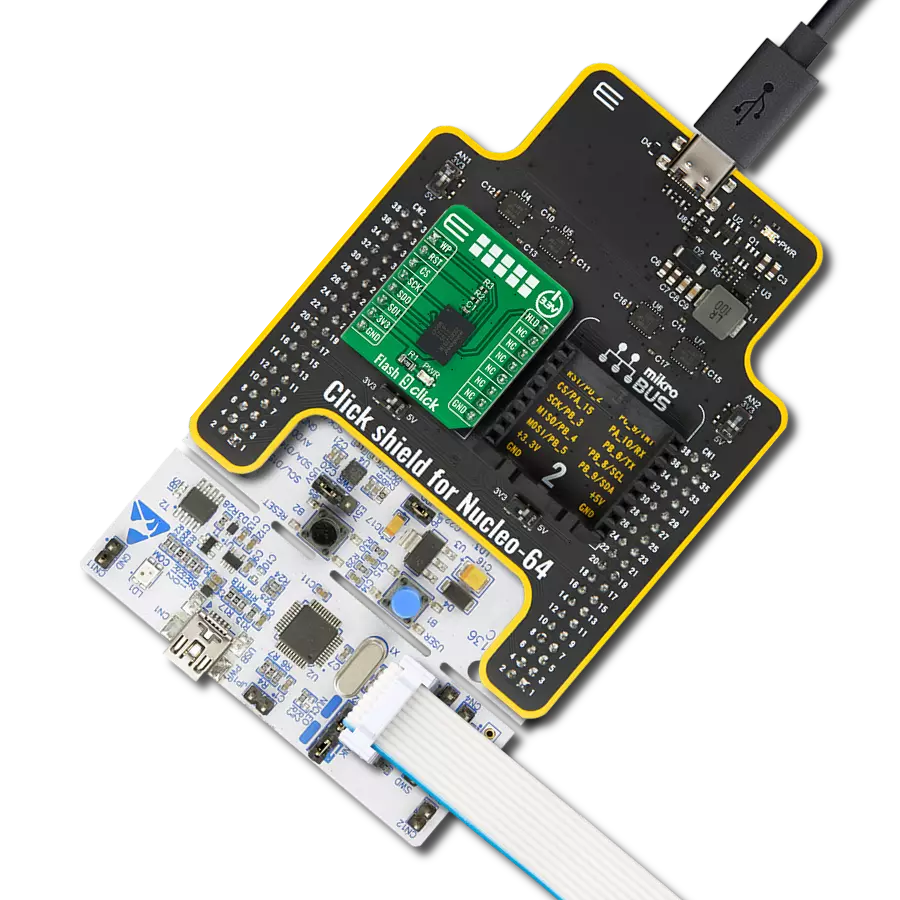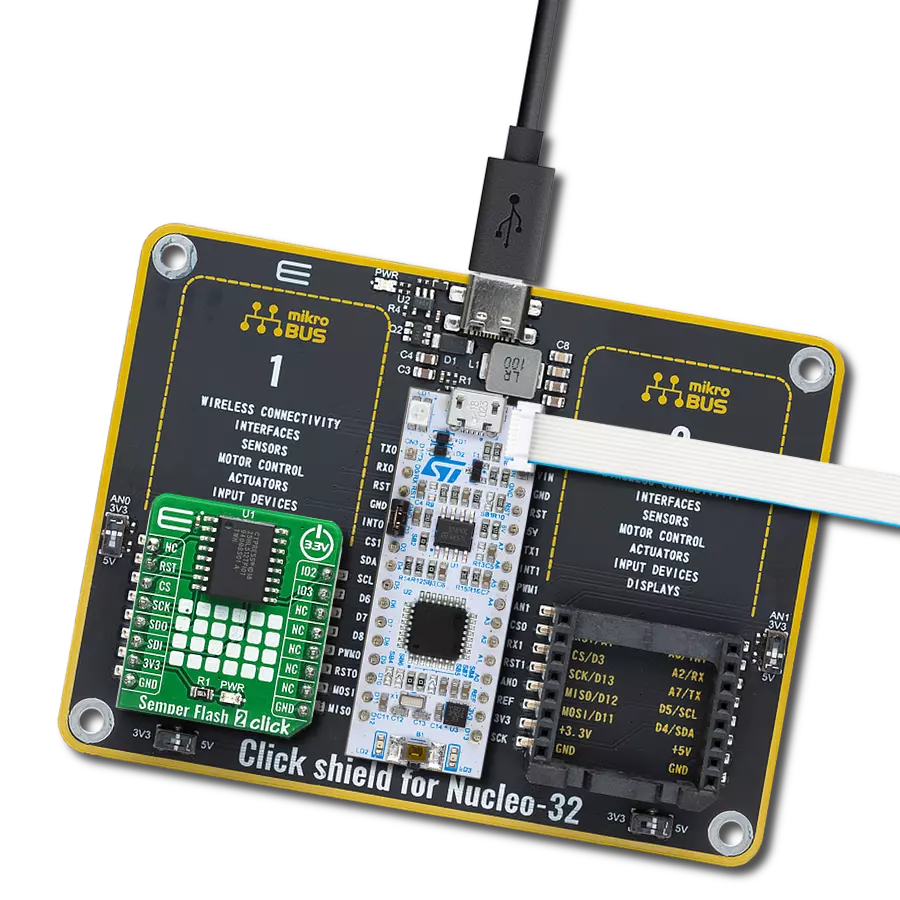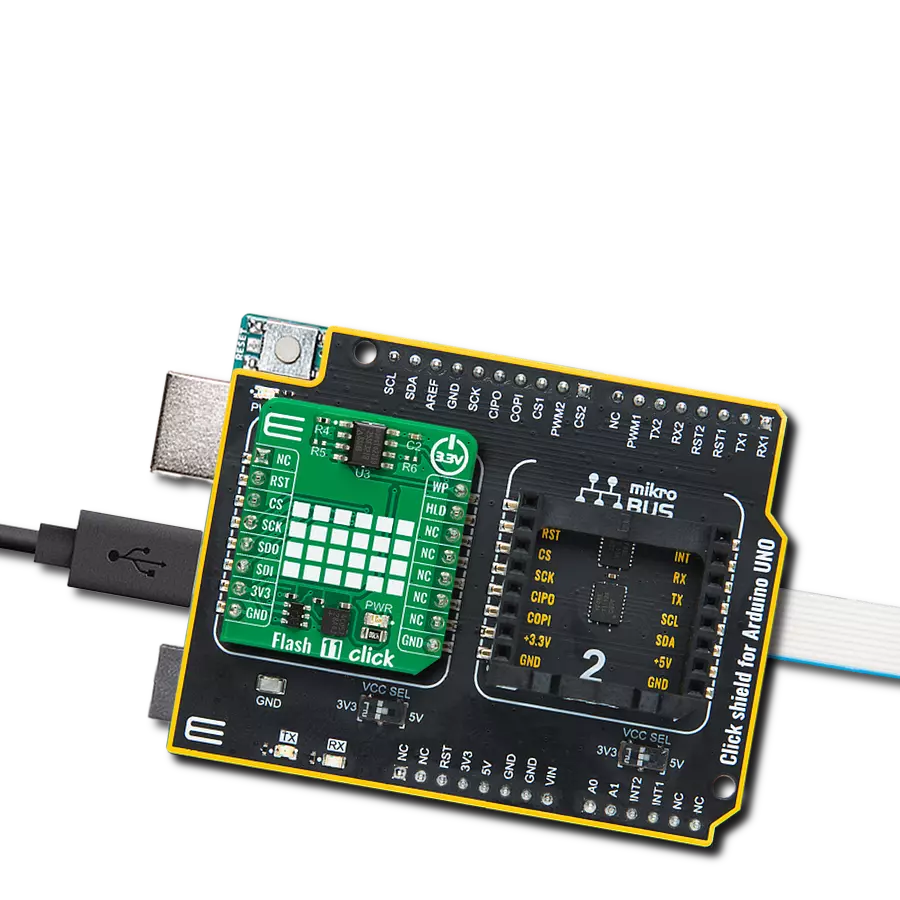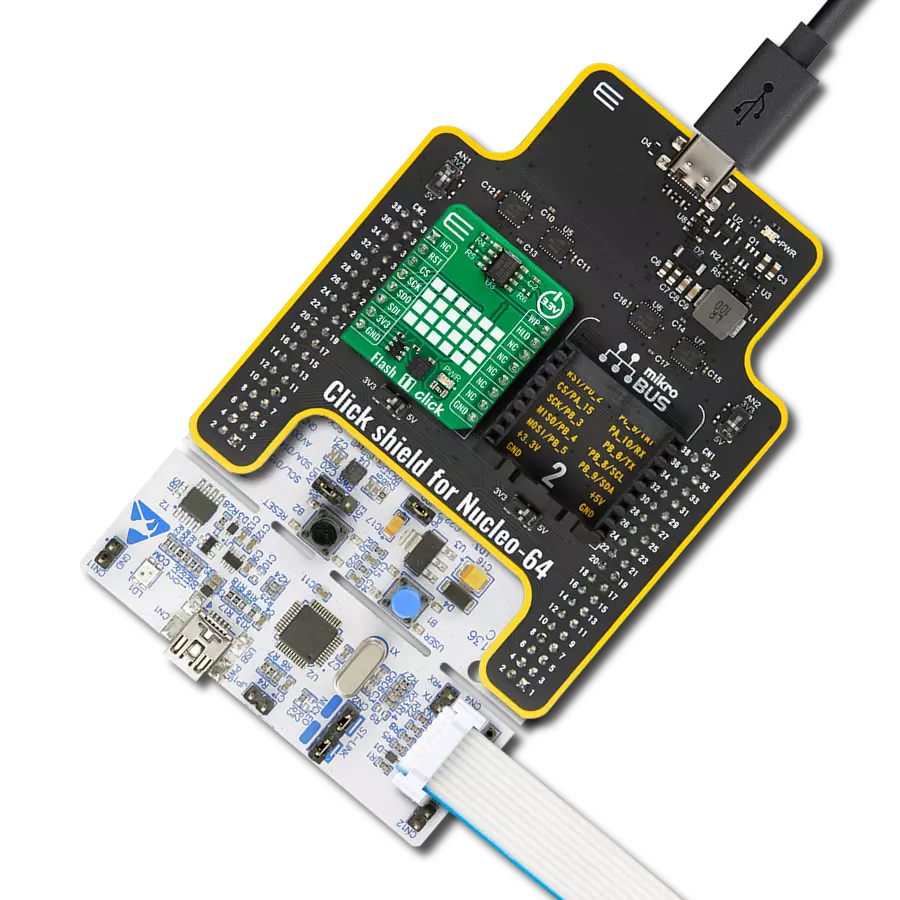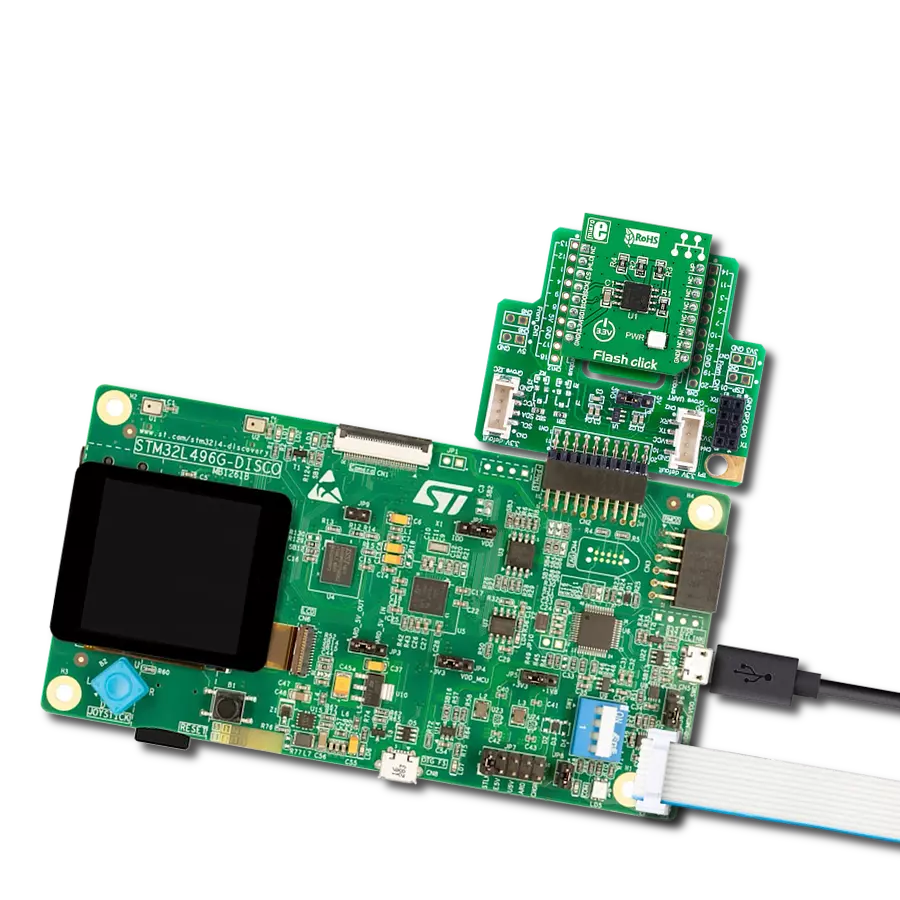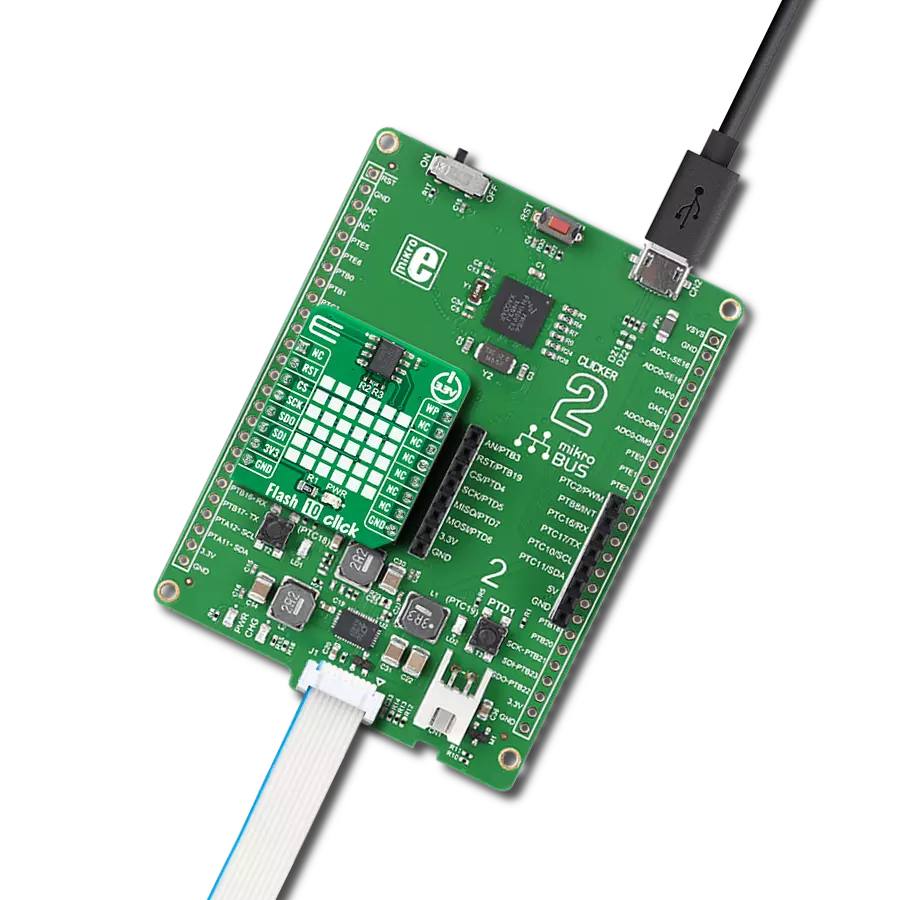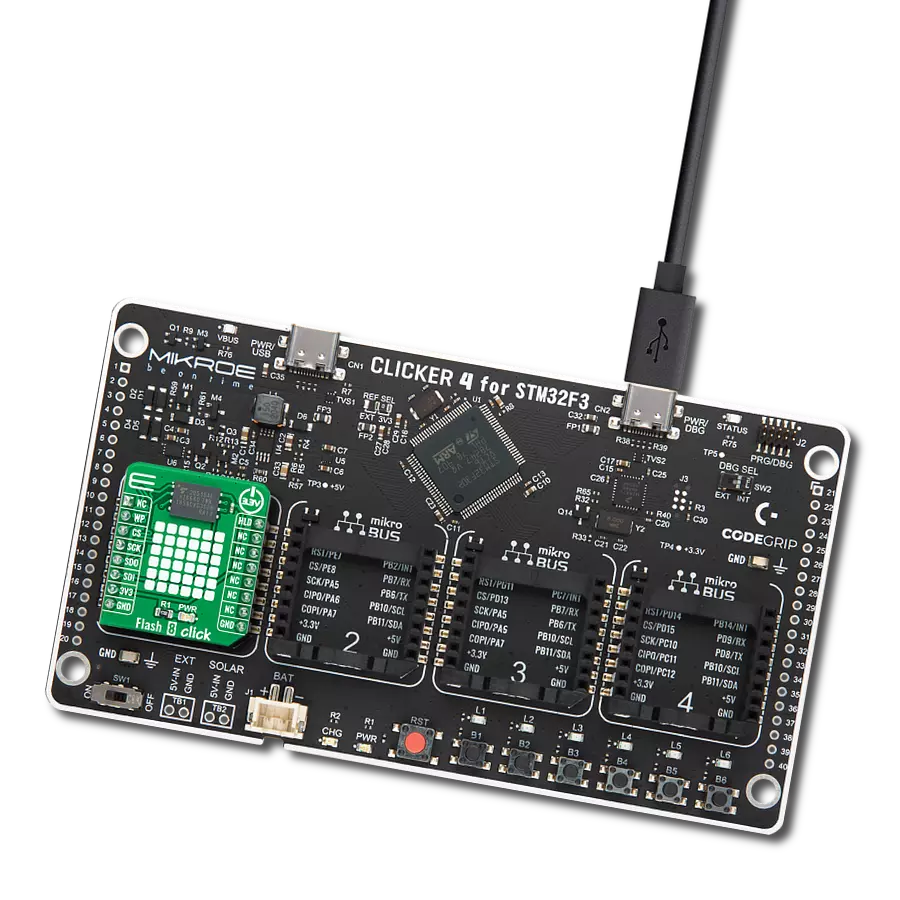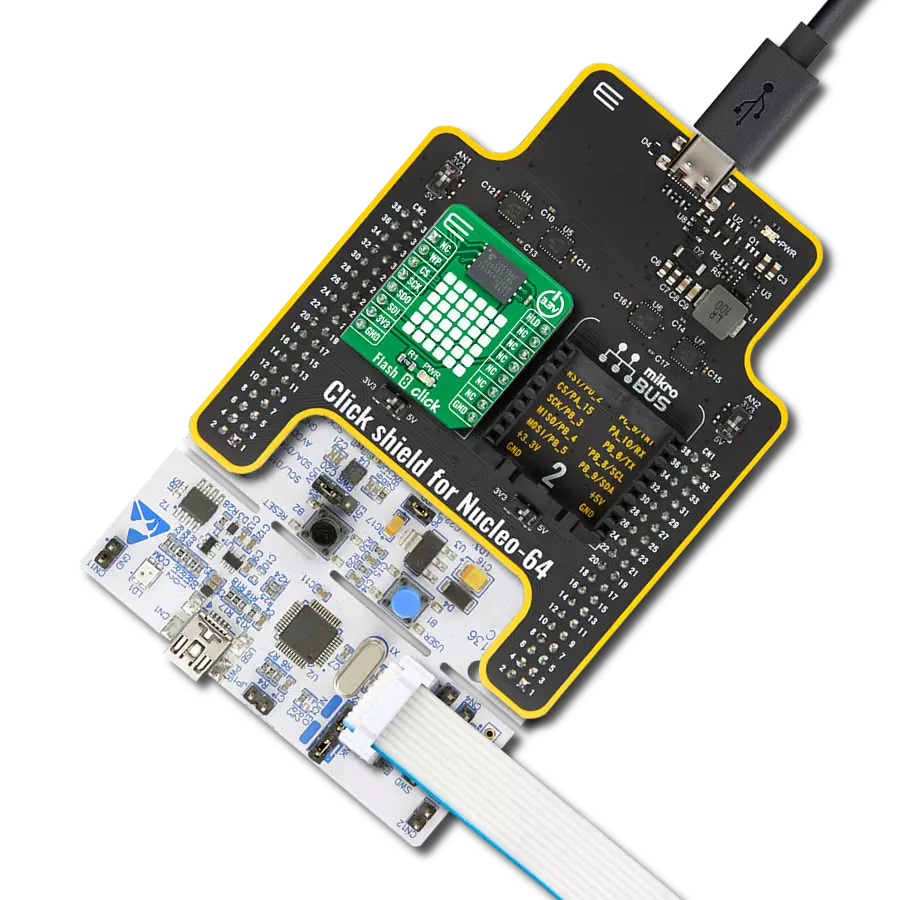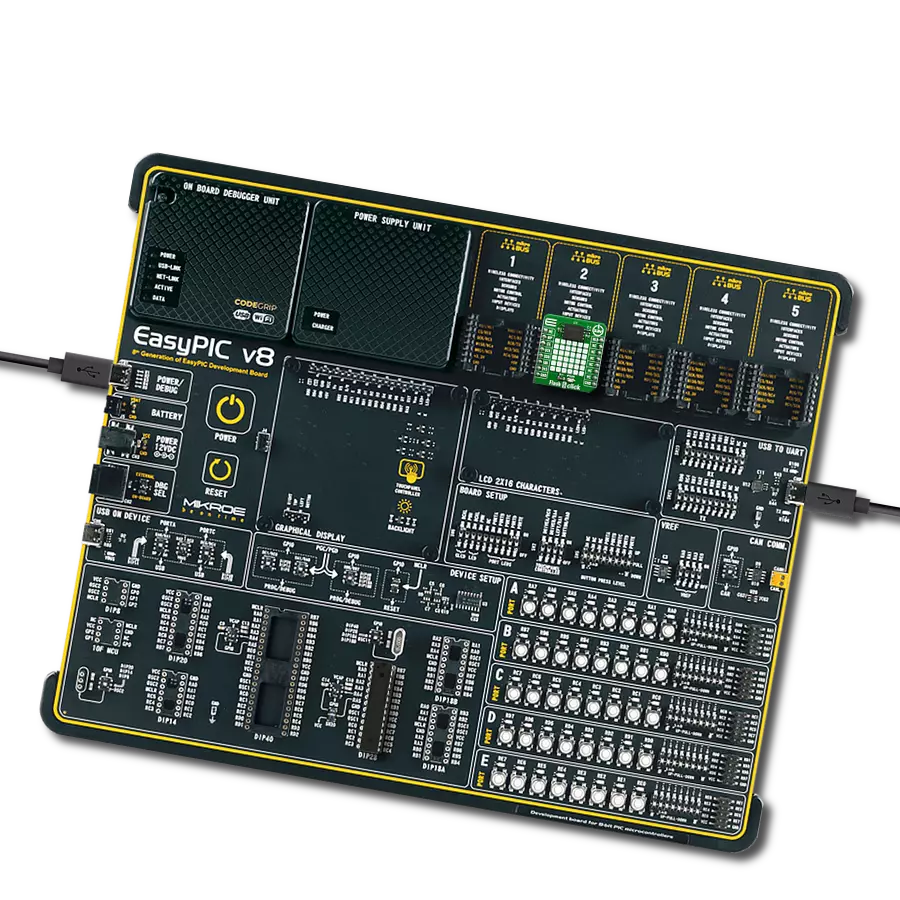Ensure reliable data retention and encryption through our flash memory solution
A
A
Hardware Overview
How does it work?
Flash 5 Click is based on the W25N01GVZEIG/IT (1G-bit) Serial SLC NAND Flash Memory from Winbond. The device operates on a single 3.3V power supply with current consumption as low as 25mA active and 10µA for standby. All W25N SpiFlash family devices are offered in space-saving packages, which were previously impossible to use for the typical NAND flash memory. The W25N01GVZEIG/IT 1G-bit memory array is organized into 65,536 programmable pages of 2,048 bytes each. The entire page can be programmed simultaneously using the data from the 2,048-Byte internal buffer. Pages can be erased in groups of 64 (128KB block erase). The W25N01GVZEIG/IT has 1,024 erasable blocks. The Flash 5 Click uses the standard Serial Peripheral Interface (SPI), supporting SPI clock frequencies of up to 104MHz. Besides that, the W25N01GVZEIG/IT provides a new Continuous Read Mode that allows for efficient access to the entire memory array with a single Read command. This feature is ideal
for code-shadowing applications. Also, it offers the highest performance thanks to the Serial NAND Flash with 104MHz Standard/Dual/Quad SPI clocks and a 50MB/S continuous data transfer rate. Given that it has an efficient “Continuous Read Mode,” it allows direct read access to the entire array. However, the performance depends on the main MCU used with this Click board™. A Hold pin, Write Protect pin and programmable write protection provide further control flexibility. Additionally, the device supports JEDEC standard manufacturer and device ID, one 2,048-Byte Unique ID page, one 2,048-Byte parameter page, and ten 2,048-Byte OTP pages. To provide better NAND flash memory manageability, user-configurable internal ECC and bad block management are also available in W25N01GVZEIG/IT. The W25N01GVZEIG/IT is accessed through an SPI-compatible bus consisting of four signals: Serial Clock (CLK), Chip Select (/CS), Serial Data Input (DI), and Serial Data
Output (DO). Standard SPI instructions use the DI input pin to serially write instructions, addresses, or data to the device on the rising edge of CLK. The DO output pin reads data or status from the device on the falling edge of CLK. For a detailed explanation, please consult the included datasheet. However, MikroElektronika provides a library that contains functions that simplify and speed up working with this device. The provided application example demonstrates the functionality of the library functions. It can be used as a reference for a custom project development. This Click board™ can be operated only with a 3.3V logic voltage level. The board must perform appropriate logic voltage level conversion before using MCUs with different logic levels. Also, it comes equipped with a library containing functions and an example code that can be used, as a reference, for further development.
Features overview
Development board
PIC18F57Q43 Curiosity Nano evaluation kit is a cutting-edge hardware platform designed to evaluate microcontrollers within the PIC18-Q43 family. Central to its design is the inclusion of the powerful PIC18F57Q43 microcontroller (MCU), offering advanced functionalities and robust performance. Key features of this evaluation kit include a yellow user LED and a responsive
mechanical user switch, providing seamless interaction and testing. The provision for a 32.768kHz crystal footprint ensures precision timing capabilities. With an onboard debugger boasting a green power and status LED, programming and debugging become intuitive and efficient. Further enhancing its utility is the Virtual serial port (CDC) and a debug GPIO channel (DGI
GPIO), offering extensive connectivity options. Powered via USB, this kit boasts an adjustable target voltage feature facilitated by the MIC5353 LDO regulator, ensuring stable operation with an output voltage ranging from 1.8V to 5.1V, with a maximum output current of 500mA, subject to ambient temperature and voltage constraints.
Microcontroller Overview
MCU Card / MCU
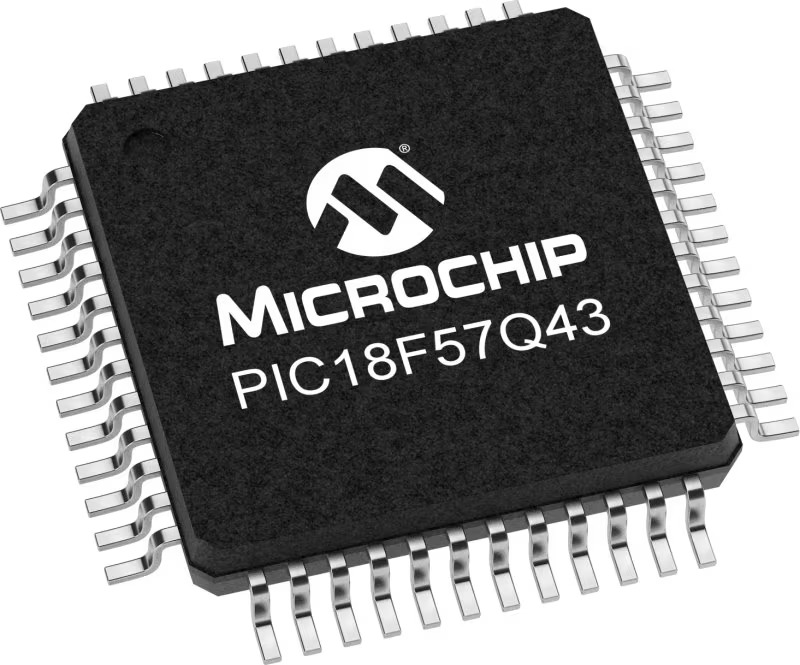
Architecture
PIC
MCU Memory (KB)
128
Silicon Vendor
Microchip
Pin count
48
RAM (Bytes)
8196
You complete me!
Accessories
Curiosity Nano Base for Click boards is a versatile hardware extension platform created to streamline the integration between Curiosity Nano kits and extension boards, tailored explicitly for the mikroBUS™-standardized Click boards and Xplained Pro extension boards. This innovative base board (shield) offers seamless connectivity and expansion possibilities, simplifying experimentation and development. Key features include USB power compatibility from the Curiosity Nano kit, alongside an alternative external power input option for enhanced flexibility. The onboard Li-Ion/LiPo charger and management circuit ensure smooth operation for battery-powered applications, simplifying usage and management. Moreover, the base incorporates a fixed 3.3V PSU dedicated to target and mikroBUS™ power rails, alongside a fixed 5.0V boost converter catering to 5V power rails of mikroBUS™ sockets, providing stable power delivery for various connected devices.
Used MCU Pins
mikroBUS™ mapper
Take a closer look
Click board™ Schematic

Step by step
Project assembly
Software Support
Library Description
This library contains API for Flash 5 Click driver.
Key functions:
flash5_page_read- Function for setting page readflash5_page_load_memory- Function for loading one pageflash5_write_status_data- Function for writing status data
Open Source
Code example
The complete application code and a ready-to-use project are available through the NECTO Studio Package Manager for direct installation in the NECTO Studio. The application code can also be found on the MIKROE GitHub account.
/*!
* \file
* \brief Flash5 Click example
*
* # Description
* This application is for storing mass storage.
*
* The demo application is composed of two sections :
*
* ## Application Init
* Initializes driver, resets device, erasing one page of memory, tests communication and configures device.
*
* ## Application Task
* Writes "MikroE" to device memory and then reads it and sends it to log.
*
* \author MikroE Team
*
*/
// ------------------------------------------------------------------- INCLUDES
#include "board.h"
#include "log.h"
#include "flash5.h"
// ------------------------------------------------------------------ VARIABLES
static flash5_t flash5;
static log_t logger;
static char write_buf[ 7 ] = { 'M', 'i', 'k', 'r', 'o', 'E', 0 };
// ------------------------------------------------------ APPLICATION FUNCTIONS
void application_init ( void )
{
log_cfg_t log_cfg;
flash5_cfg_t cfg;
uint8_t device_check = 0;
/**
* Logger initialization.
* Default baud rate: 115200
* Default log level: LOG_LEVEL_DEBUG
* @note If USB_UART_RX and USB_UART_TX
* are defined as HAL_PIN_NC, you will
* need to define them manually for log to work.
* See @b LOG_MAP_USB_UART macro definition for detailed explanation.
*/
LOG_MAP_USB_UART( log_cfg );
log_init( &logger, &log_cfg );
log_info( &logger, "---- Application Init ----" );
// Click initialization.
flash5_cfg_setup( &cfg );
FLASH5_MAP_MIKROBUS( cfg, MIKROBUS_1 );
flash5_init( &flash5, &cfg );
log_printf( &logger, " - Reseting device... \r\n" );
flash5_software_reset( &flash5 );
Delay_ms ( 1000 );
log_printf( &logger, " - Erasing memory... \r\n" );
flash5_send_cmd( &flash5, FLASH5_CMD_WRITE_ENABLE );
flash5_erase_page_data( &flash5, 0x0001 );
device_check = flash5_device_id_check( &flash5 );
if ( device_check == FLASH5_DEVICE_OK )
{
log_printf( &logger, " - Device OK \r\n" );
}
else
{
log_printf( &logger, " - Device Error \r\n" );
for( ; ; );
}
Delay_ms ( 100 );
log_printf( &logger, " - Configuring device \r\n" );
flash5_write_status_data( &flash5, FLASH5_CMD_WRITE_REG_STATUS1, FLASH5_REG_STATUS_1, FLASH5_RS1_WRITE_PROTECTION_DISABLE |
FLASH5_RS1_SRP1_ENABLE );
flash5_write_status_data( &flash5, FLASH5_CMD_WRITE_REG_STATUS1, FLASH5_REG_STATUS_1, FLASH5_RS2_PAGE_READ_MODE );
Delay_ms ( 1000 );
log_printf( &logger, "***** App init ***** \r\n" );
log_printf( &logger, "------------------- \r\n" );
Delay_ms ( 500 );
}
void application_task ( )
{
char read_buf[ 6 ];
uint8_t n_counter;
flash5_send_cmd( &flash5, FLASH5_CMD_WRITE_ENABLE );
flash5_page_load_memory( &flash5, 0x000A, &write_buf[ 0 ], 6 );
flash5_page_read_memory( &flash5, 0x000A, &read_buf[ 0 ], 6 );
for( n_counter = 0; n_counter < 6; n_counter++ )
{
log_printf( &logger, " %c ", read_buf[ n_counter ] );
Delay_ms ( 100 );
}
log_printf( &logger, " \r\n" );
log_printf( &logger, "------------------- \r\n" );
Delay_ms ( 1000 );
Delay_ms ( 1000 );
Delay_ms ( 1000 );
Delay_ms ( 1000 );
Delay_ms ( 1000 );
}
int main ( void )
{
/* Do not remove this line or clock might not be set correctly. */
#ifdef PREINIT_SUPPORTED
preinit();
#endif
application_init( );
for ( ; ; )
{
application_task( );
}
return 0;
}
// ------------------------------------------------------------------------ END
Additional Support
Resources
Category:FLASH






















